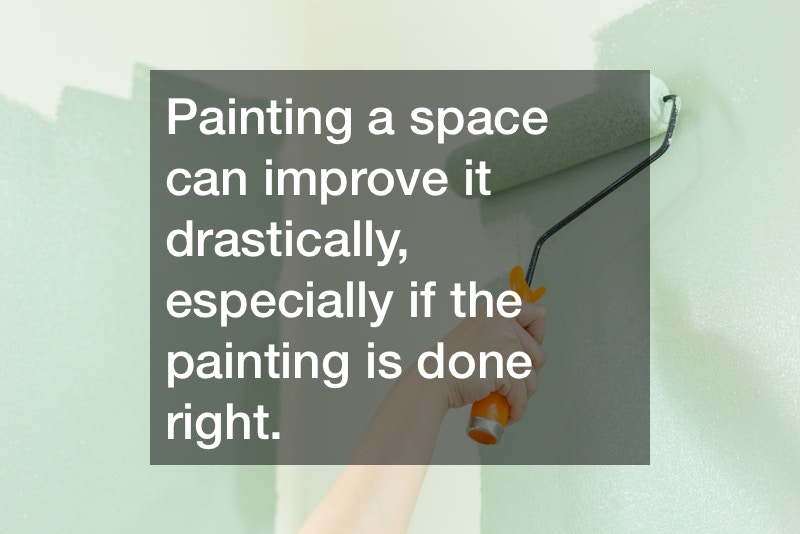
Painting a space can improve it drastically, especially if the painting is done right. If you’d like to see just how this is the case, you should search online for things like ” residential exterior painting jobs.” Exterior painting pros are typically known to be expensive, but the job that they do is well worth the cost.
To prepare yourself for the process, you also need to look for quotes for house painting so you can prepare a fitting budget. You can find this online by making a search for something like “cost to paint exterior windows.” It’s also a good idea to be informed about the process by finding out “how many coats of paint for exterior house?” and more.
When you know what to expect from the process, you may be in a better position to realize if the painter you hired is a professional or whether they’re doing a bad job.
Remember that you can negotiate the price that you’re quoted and also shop around for different professionals. Keep your expectations in check while looking for a good price because there’s a minimum price that any expert worth their salt will ask for. An amount that’s lower than this will probably leave you with an undesirable end result.
For professional painters, preparing the surface before painting ensures excellent adhesion of paint, protecting the underneath surface material and increasing paint durability. This is achieved using a primer and it helps create a smooth and level surface that’s ready for painting.
But some painting work doesn’t require the need for surface preparation using primers. This is why you need to understand the different types of primers and their immediate application to identify which painting projects requires primers. Here is a look at types of primer for painting and the right surfaces to apply.
Drywall Primer
Bare drywalls absorb paint vigorously and therefore without drywall primers you’ll end up with uneven painted surface after applying several topcoats. Wall primers are used to achieve a uniform appearance and they cost less than using many coats of high-quality self-priming interior paint. You can also consider using an eco friendly primer for a safe environment, especially if you are choosing the best paint for a porch.
Stain-Blocking Primer
For stain-blockers, there are several options intended for specific uses, but they are commonly used in moisture-prone and smoke areas like the kitchen to prevent bleed-through the finish coat.
Use a stain-blocking primer for painting over crayon and marker stains. This paint also helps to make a color change on any surface from a much darker shade to a lighter shade.
Concrete, Brick, Stone and Masonry Primer
If you are looking for a more advanced type of primer for painting on various surfaces such as cement, concrete, stone, brick, plaster, then consider masonry primer. Masonry primer helps address most of the defects in brick masonry such as brick cracking and spalling. The defects are often are a result of high pH levels on masonry surfaces caused by direct painting, but a good primer ensures proper adhesion across the pH range.
In addition to high pH levels, efflorescence is another common concern when painting. This is a white or greyish crystalline deposit of salts that usually forms on masonry surfaces that are exposed to high moisture content. The deposits form when water evaporates, leaving a damaged and ugly looking surface behind. So make sure you choose a masonry primer that is efflorescent-resistant, especially if you are going to paint surfaces exposed to high moisture content.
Bonding Primer
Boding primer is suitable for interior and exterior surfaces that require superior adhesion than what standard primers can offer. Some examples of slick surfaces that pose an adhesion challenge with paint include clear-coat finishes, metal, ceramic tile, metal and surfaces with glossy finishes. Find the right bonding primer for painting and ensure strong adhesion and bonding between the finish coat and the surface.
Wood Primer
Like bare walls, getting a paint topcoat to properly adhere to bare wood is a challenge. Initially, people used slow-drying oil-based wood primer on bare wood but it would essentially take up to 24 hours to dry. While the longer it takes the better it soaks and sticks into the wood, this would mean that you have to wait that long to apply the finishing coat.
With the benefits of old fashioned oil primer still standing, paint manufacturers have come up with advanced, faster-drying wood primer in both oil and latex option that dry quickly while ensuring proper surface adhesion.
Multi-Purpose Primers
The improved paint technology has seen the introduction of more universal primers that can be applied to different types of surfaces. You need to be sure the multi-purpose primer is right for your application by checking the labels on the packaging.
Generally, you won’t need to prime a surface that has been previously painted. All you need is selective-priming any bare surfaces that need to be corrected before you topcoat it.
If you’re doing a fresh coat over a bare surface, it’s important to consider the following options above to find the right primer for our specific project needs.

